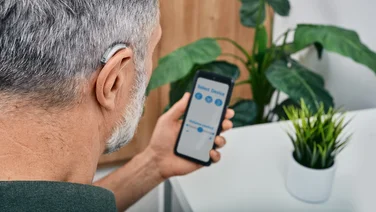To help us provide you with free impartial advice, we may earn a commission if you buy through links on our site. Learn more

Choosing your hearing aid can be a tricky and potentially expensive path to navigate. That’s why we’ve delved into the world of Boots’ hearing aids costs to decode the system and help you choose the device that’s right for your needs.
In short, Boots hearing aids are priced according to a tier system: affordable, entry-level models are categorised into the Essentials tier (from £595); go up a rung and you have the Essentials+ tier, then there’s Bronze, Silver, Gold and Platinum (with prices up to £3,395). Confusingly, these models aren’t categorised by price alone: the most expensive in the Silver category is actually £250 more than the cheapest in the Gold category, for instance.
Boots Hearingcare says that it determines the price of its hearing aid packages according to the model of hearing aid you choose, not the intensity of your hearing loss. If you’re suffering from severe hearing loss, don’t worry that you’ll necessarily be lumped with a corresponding price tag: it’s the raft of features and extras which drive the price of models up.
Read on for our guide to what you’re paying for and why.
If you have an idea of your requirements, use our free quote finder tool to be matched to a local hearing aid specalist.
Get a free hearing aid quote today
Looking for a quote for hearing aids? Take our quick survery below and we’ll help you find a quote for your exact requirements.
Boots hearing aid prices: At a glance
Here’s a quick guide to the tier system Boots uses and the price ranges within each one.
- Essentials: £595 – £1,145
- Essentials+: £1,395 – £1,635
- Bronze: £2,295 – £2,745
- Silver: £2,595 – £3,045
- Gold: £2,795 – £3,195
- Platinum: £2,995 – £3,395
READ NEXT: How do hearing aids work?
Boots hearing aid prices, explained
Although the tiers above share similarities, there are a few common themes worth noting. As you pay more, you’re going to get:
- More advanced features
- More customisation options
On the other hand, some things don’t change. In-the-ear (ITE), behind-the-ear (BTE) and receiver-in-canal (RIC) hearing aids are available in all tiers, so to a degree you needn’t worry about paying extra for more discreet options.

In addition, certain features are now standard across almost all of Boots’ hearing aids. These are:
- Bluetooth
- Telecoil options
- Basic smartphone app support
- Choice of battery-powered or rechargeable
You should still check the specifications, of course, but as a general rule these things do not add as much to the cost as certain advanced features.
Interested in finding out how much hearing aids could cost you?
Find the best provider for you
Boots hearing aid prices: Which features do I pay more for?
Specifically, you can expect to pay more for any of the following:
Water resistance: Not to be confused with proper waterproofing. The most water-resistant hearing aids can survive being immersed up to 50cm for a short period.
Speech enhancement: Automatically adjusting speech so that it sounds clearer even in noisy environments.
Noise cancelling: Blocking out unwanted external sounds eg. the hum of a plane’s engine or the rattle of a commuter train.
Tinnitus balance: Reducing the effects of your tinnitus.
Hands-free calling/two-way audio: Using your hearing aid to take calls or record your voice.
Health data tracking: Like a fitness tracker, some hearing aids can monitor your sleep, steps or heart rate.
Advanced smartphone app: Most hearing aids connect to a companion app that lets you adjust volume, but some also offer a raft of extra features such as live transcribing, usage data and reminders.
Charging case: Brands may sell carry cases that can hold multiple charges, like a pair of wireless earbuds.
It’s not completely black and white (some hearing aids are more expensive simply because they look/perform better) but it’s still worth thinking about whether you need any of the above before plumping for an expensive model.
READ NEXT: How to put hearing aids in
Boots hearing aid prices: Which brand should I buy?
At Boots, you currently have a choice of four major players in the world of hearing aids:
- Starkey
- Phonak
- Coselgi
- AudioNova
These brands all offer various product ranges at Boots, each characterised by specific advanced features:
| Product range | No. of products | Types available | Key features |
| Starkey Evolv | 7 | ITE, BTE and RIC |
|
| Starkey Livio | 1 | ITE, BTE and RIC |
|
| Phonak Paradise Virto/Virto Titanium | 8 | ITE |
|
| Phonak Paradise Naida | 4 | BTE |
|
| Phonak Paradise Fit | 2 | RIC |
|
| Phonak Audeo Lumity/Lumity Slim/Lumity Life | 10 | RIC |
|
| Coselgi M | 12 | ITE and BTE |
|
| AudioNova DX | 7 | ITE, BTE and RIC |
|
| AudioNova B | 3 | RIC |
|
Within each range, you’ll find multiple hearing aid models spread across Boots’ tiers. For example, Coselgi’s M range has a model in every single tier from Essential to Platinum, while Phonak’s Paradise Fit range is exclusive to Gold and Platinum tiers.
However, while the table above explains what you can expect from the category as a whole, it’s almost impossible to work out exactly how the various models differ without taking a test or booking an appointment.
Interested in finding out how much hearing aids could cost you?
Find the best provider for you
Boots hearing aid prices: Which hearing aid package should I pick?
That’s why we recommend you do exactly that. If you’re concerned about your hearing and want to seek further guidance, you can book a hearing appointment with a specialist via our sister site HearClear.
You can also take Boots’ Hearing Aid Finder quiz to find out your recommended hearing aid(s) according to level of hearing loss experienced; requirement for tinnitus solutions; contexts in which you’d like to hear better (windy environments or small group conversations for instance); and how important features like rechargeable batteries and connectivity are to you.






